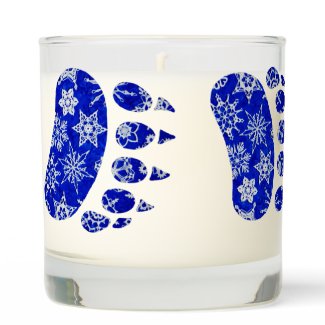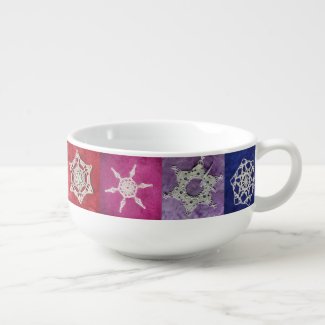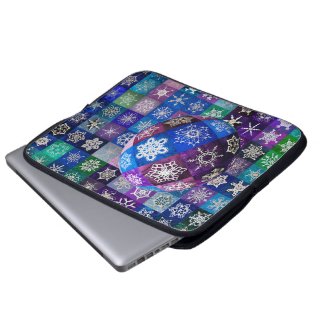Hi, people! I decided to commandeer Snowcatcher's site. Instead of snowflakes, we're going to apply some physics, remove rust and administer the art of tender loving care to the bottom bracket of Snowcatcher's road bike. For those wondering, there are several bottom bracket designs. In this case, the bottom bracket is simply an aluminum tube containing a cluster of ball bearings on each side. A spindle runs through the center of the aluminum tube and bearing clusters. Crank arms (pedals) attach to the spindle, allowing a cyclist to smoothly pedal.
Early last summer, Snowcatcher's bottom bracket developed a tick. No problem, I figured. I would easily change it out some evening. I even had a new bottom bracket "in stock" sitting on my shop shelf. That evening came, and I pulled the cranks and began to remove the bottom bracket. I couldn't break it free. I assumed rust. Despite the clicking noise, the spindle turned well and the bearings seemed to be working okay. However, Snowcatcher had several rides coming up, and I didn't want to get too Herculean with the frame should the problem be cross-threading or something drastic. So, I let it go until her sanctioned rides were finished or it became an emergency. Well, events came and went, and an emergency never materialized. Now I'm finally getting to the task.
The bottom bracket is original and has close to 15,000 miles on it. I'm quite impressed with this bottom bracket! It's a Shimano Ultegra, meaning it's an upper end bottom bracket that has more than performed as expected. To get things going I pulled the cranks and applied some penetrating oil to the bottom bracket/frame interface. This step likely didn't do much, but who knows.
Leverage was needed more than anything. Hmmmm... this might work. I had some 1.25-inch, schedule 80 PVC, electrical tubing and 12 inches of crescent wrench. Meet Big Bertha, all five feet of her!
In order to keep the bottom bracket cup remover tool attached to the old bottom bracket while I flailed around with Bertha and the bike, I bolted the tool to the bottom bracket via the hollow spindle. The crescent wrench handle had to be tapped into the 1.25-inch PVC. The tool was fairly solid feeling when done.
I didn't really have any way to attach the bike to the floor. So, I did my best to cloak my body over the frame, still maintaining the freedom to leverage Bertha. HEAVE! Nothing! HEAVE! Did I feel slippage? AGAIN! Was that more slippage, ever so slight? Man, this thing is seized up. At this point, I was worried I may be stripping the threads. Oh well, we're committed. I pushed again and it became easier, I could see separation between frame and bottom bracket. So far, things were going well. Although, I knew the frame's shell threads were going to need some care. Now on to the right side of the bike, the side where the crank with chainrings (sprockets) is located. Bottom bracket shell threads on this side are left hand. So, after a short stint conducting music with my hands, I'm confident I'm going to be leveraging in the correct direction. HEAVE! Nothing. AGAIN! The cup gives and begins to back out. It's not as seized up on this side and begins backing out easily. Success!
Oh my goodness me! Just a little rusted are we? A red-headed step-child if I'd ever seen one. The original bottom bracket cup threads are alloy, and not too bad. However, there was good rust build-up inside the frame's shell, enough to make bearing removal a bear. Considering the frame is steel (Columbus tubing - very good stuff), sporting an original bottom bracket that has not seen daylight in many, many moons, things aren't so bad.
With an army of WD-40, heavier oil, toothbrush, steel wool, paper towels and rags, we attacked the rust as best we could. The rust seemed to clean up sufficiently; none of the frame threads appeared to be eaten away. The non-slip compound dabbed on the original bottom bracket cup threads by the factory had also fossilized a bit since original installation.
For about 24 hours I cleaned and reapplied oils to the bottom bracket shell. I was attempting to break up and eat as much rust and oxidation as possible. Slowly we began to reach an acceptable level of clean. In time, a clean thread became a happy thread. Then I greased the heck out of everything in the frame's bottom bracket shell.
Even when internally coated with a rust inhibitor, as manufactures claim to do, steel does rust. All my steel bikes have had rust. Washing, riding in rain, sudden temperature variation leading to condensation (from cold outside to warm inside) all contribute to rust over time. Nonetheless, steel is real and the ride awesome. There is a reason custom frame builders still work with steel. There also seems to be renewed interest, along with some R&D, in stainless steel, too. Perhaps there is a steel renaissance on the horizon? Time will tell.
The bottom bracket spindle/ crank arm interface is very susceptible to creaking. It puts up with a lot of force while a rider pedals. Under heavy loads it can undergo some flex and creak. An avid antagonist to creaking, I like to use a lot of grease on the spindle.
I use a lot of grease on the crank arms, as well.
Finally it's time to install and tighten/ torque the cranks, and the Specialized Allez Comp is ready for bear!
And there you have it! Now all you Rosie Riveters get after it! Impress dear hubby with a bottom bracket overhaul. I got a backrub out of the deal and so could you!
Lizard Lives...





































Oy. Much too technical for me, but looks like you did a nice job. I think you deserve some Peanuts.
ReplyDeleteThree cheers for The Lizard! Love that you took over the site today... that is an impressive amount of rust- it's amazing that she was able to use the bike at ALL.
ReplyDeleteGotta send this link to my favorite bike mechanic- he's the one in charge of the toolbox. If this 'Rosie Riveter' has to get involved in a fix, it's a serious epic.
Awesome post. More is required.
Hip Hip Hurray! Hip Hip Hurray! I Did that once a long time ago. Never Again!
ReplyDeleteI'll have to show this to Mr. M, the resident bike mechanic in our house. He'll appreciate it even more than I did.
ReplyDeleteStout effort, Lizard!
I dig Lizards! alaways impressed at the time you take to photo-document a place/object/task
ReplyDeleteMrs. Micawber has a 25 year old Cannondale that occassionally requires my tlc. As far as cleaned metal surfaces are concerned - especially the sacred 'Columbus' tubes - you might try 'Penetrol' applied to clean metal as it is a superior (and inexpensive) surface protectant and excellent rust inhibitor. Grease does collect moisture and dirt, Penetrol doesn't. Grease requires annual refreshing, Penetrol doesn't. The application technique that has produced the best results for me (after much experimentation) is the proper application of Penetrol to a very clean and very dry metal surface. After application, let it set up for at least 24 hours - and then apply a coat of wax - Johnson's Paste Wax works well. Let the wax set up for another 24 hours or so, then buff (not for the purpose of polishing, but merely to remove excess residue). Yes, I know the whole process takes time, but it is a very prudent use of time, in my humble opinion. This treatment should easily see you through several Colorado riding seasons.
ReplyDeleteI love Bertha the bottom bracket tool! We have a PVC cheater but it pales in comparison to yours.
ReplyDeleteI'm so jealous of people with mechanical wizardry to fix something like a bottom bracket. I can do the basics on my bike but nothing like the job that you did!
Love the Moab photo!
Yes! The Lizard lives!
ReplyDeleteWow! This was some post! Sorry for all the excitement but this story had me on the edge of my chair!
I, too, am an avid antagonist to creaking!!!!!
When my Recumbent Bike did that, it drove me nuts until I fixed it!
I am sending this one for my son to read.
Ha, ha!! My word verification was: skunc